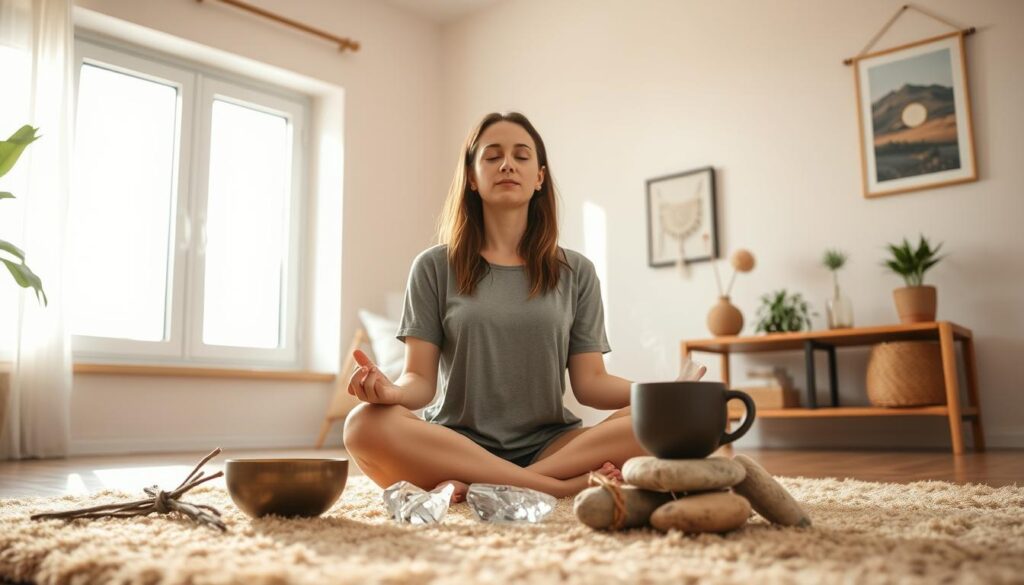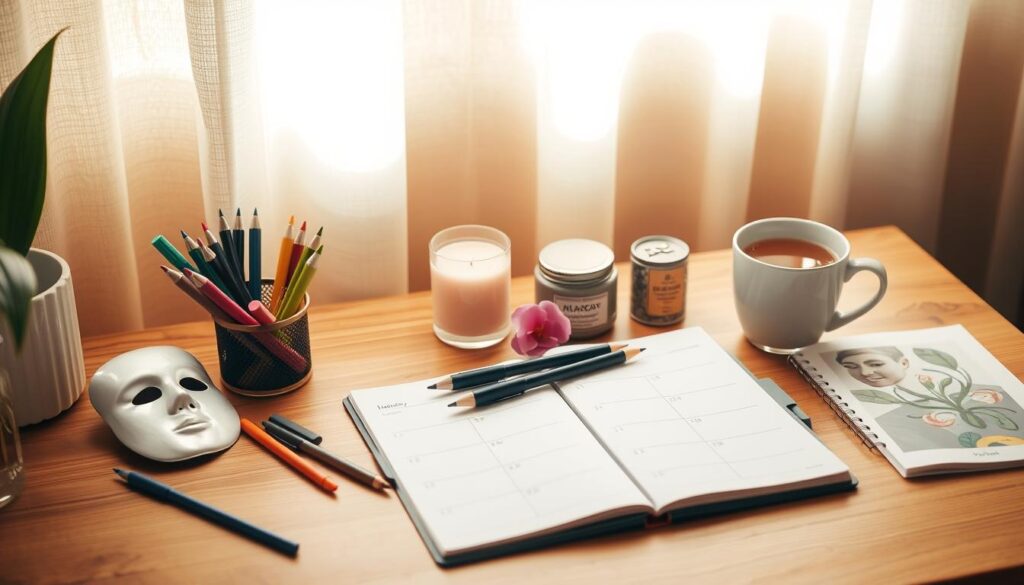As a busy woman, it’s easy to get caught up in the hustle and bustle of daily life and forget to prioritize your own well-being. However, neglecting self-care can lead to burnout and decreased productivity. Establishing a self-care routine can help you recharge and maintain a healthy work-life balance.
Engaging in regular self-care activities can have a profound impact on both physical and mental health. By incorporating simple yet effective rituals into your weekly routine, you can improve your overall well-being and increase your resilience to stress.
Key Takeaways
- Prioritizing self-care is essential for maintaining overall well-being.
- A consistent self-care routine can help reduce stress and increase productivity.
- Simple self-care activities can be easily incorporated into a busy lifestyle.
- Regular self-care can improve mental and physical health.
- Establishing weekly self-care rituals can lead to long-term benefits.
Understanding the Importance of Self-Care for Busy Women
Self-care is not a luxury, but a necessity for women juggling multiple responsibilities. In today’s fast-paced world, it’s easy to get caught up in the hustle and bustle, leaving personal care on the backburner. However, neglecting self-care can have serious consequences on both physical and mental health.
The Physical and Mental Benefits of Regular Self-Care
Regular self-care practices offer numerous benefits, from reducing stress to boosting overall well-being. By incorporating simple self-care rituals into daily routines, busy women can experience significant improvements in their quality of life.
Stress Reduction and Immune System Support
Self-care activities like meditation and deep breathing exercises can help mitigate the negative effects of stress. By activating the parasympathetic nervous system, these practices promote relaxation and support immune function. Studies have shown that regular self-care can lead to lower cortisol levels, reduced blood pressure, and a stronger immune system.
Enhanced Productivity and Decision-Making
Prioritizing self-care can also have a positive impact on productivity and decision-making. By taking time to recharge, busy women can approach tasks with renewed energy and clarity, leading to better outcomes in both personal and professional spheres. A clear mind is more capable of making informed decisions and tackling challenges effectively.
| Self-Care Practice | Physical Benefits | Mental Benefits |
|---|---|---|
| Meditation | Lower blood pressure | Reduced stress |
| Exercise | Improved cardiovascular health | Boosted mood |
| Journaling | Improved sleep | Enhanced self-awareness |
Why Busy Women Often Neglect Self-Care
Despite the benefits, many busy women still struggle to prioritize self-care. Societal pressures and misconceptions about self-care being selfish often contribute to this neglect.
The Societal Pressure of “Doing It All”
The expectation that women can effortlessly manage work, family, and social obligations without showing signs of strain can lead to burnout. The pressure to be perfect can be overwhelming, causing many to sacrifice their own needs.
Misconceptions About Self-Care Being Selfish
Some women view self-care as indulgent or selfish. However, taking care of oneself is essential to being able to care for others effectively. By reframing self-care as a necessary investment in their well-being, busy women can begin to prioritize their own needs without guilt.
Creating a Sustainable Self-Care Framework
To achieve wellness, it’s essential to develop a self-care framework that fits your lifestyle. This involves understanding your personal needs and setting realistic goals.
Identifying Your Personal Self-Care Needs
Understanding your self-care needs is the first step towards creating an effective routine. This involves assessing different dimensions of your well-being.
The Four Dimensions: Physical, Mental, Emotional, and Spiritual
Self-care encompasses four key dimensions:
- Physical: Relates to your body’s needs, such as exercise, nutrition, and rest.
- Mental: Involves activities that stimulate your mind, like reading or puzzles.
- Emotional: Focuses on managing your emotions and building resilience.
- Spiritual: Concerned with finding purpose and meaning in life.
Self-Assessment Tools and Questions
To identify your needs, ask yourself:
- What activities make me feel relaxed and rejuvenated?
- Are there areas in my life where I feel drained or unhappy?
- What are my long-term wellness goals?
Reflecting on these questions can help you pinpoint where to focus your self-care efforts.

Setting Realistic Expectations and Boundaries
Once you’ve identified your needs, it’s crucial to set achievable goals and boundaries.
Starting Small: The 5-Minute Rule
Begin with small, manageable self-care practices. The 5-Minute Rule suggests starting with just 5 minutes a day, making it easier to commit to your routine.
Learning to Say No Without Guilt
Setting boundaries is vital. Learning to say no without feeling guilty allows you to protect your time and energy for self-care.
Monday: Mindful Morning Rituals to Start Your Week
Mindful morning rituals on Mondays can set a positive tone for the rest of the week. Incorporating mindfulness into your morning routine can enhance your overall well-being and prepare you to tackle the challenges ahead.
5-Minute Meditation Practices
Starting your day with a short meditation practice can significantly impact your mental clarity and focus. Even a 5-minute meditation session can be beneficial.
Guided Morning Affirmations
Using guided morning affirmations during meditation can help rewire your brain to focus on positive outcomes. Repeat phrases such as “I am capable and confident” to boost your self-esteem.
“The mind is everything; what you think, you become.” – Buddha
Breathing Techniques for Clarity
Deep breathing exercises can calm your mind and improve concentration. Try inhaling for a count of four, holding your breath for four, and exhaling for four to achieve a state of relaxation.
Intentional Breakfast Routines
Eating a nutritious breakfast mindfully can be a great way to start the day. Savor each bite, and enjoy the flavors and textures of your meal.
Quick Nutritious Options for Energy
Preparing a quick and healthy breakfast can be simple. Consider options like overnight oats or avocado toast for a nutritious start.
| Breakfast Option | Nutritional Benefits | Prep Time |
|---|---|---|
| Overnight Oats | High in fiber, protein | 5 minutes |
| Avocado Toast | Rich in healthy fats, fiber | 10 minutes |
Setting Weekly Intentions
Defining your weekly intentions can help you stay focused on your goals. Take a few minutes each Monday to reflect on what you want to achieve.
The Power of Writing Down Three Priorities
Writing down your top three priorities can clarify your focus. This simple practice helps ensure you’re allocating your time and energy effectively.

By incorporating these mindful morning rituals into your Monday routine, you can cultivate a more positive and productive mindset for the week ahead.
Tuesday: Quick Physical Wellness Practices
Incorporating quick physical wellness practices into your Tuesday routine can significantly enhance your mental and physical well-being. These practices are designed to be short, effective, and easily integrated into a busy schedule.
15-Minute Home Workouts
Short workouts can be incredibly beneficial. They not only improve physical health but also boost mental energy.
No-Equipment Strength Exercises
Bodyweight exercises like push-ups, squats, and lunges are effective for building strength without any equipment.
Yoga Flows for Energy and Focus
Simple yoga flows can enhance flexibility and reduce stress. They are perfect for a quick energy boost.
Desk Stretches for Office Workers
Desk stretches are essential for office workers to relieve tension and improve posture.
Relieving Neck and Shoulder Tension
Simple stretches like neck rolls and shoulder shrugs can significantly reduce tension.
Hydration Strategies Throughout the Day
Staying hydrated is crucial for maintaining energy levels and overall health.
Infused Water Ideas for Busy Schedules
Infusing water with fruits or herbs can make hydration more enjoyable. Try combinations like lemon and mint or cucumber and lime.
| Hydration Tip | Benefit |
|---|---|
| Drink a glass of water as soon as you wake up | Boosts metabolism and rehydrates after a night of sleep |
| Infuse water with fruits or herbs | Makes water more enjoyable to drink, encouraging higher intake |
| Keep a water bottle at your desk | Reminds you to drink water throughout the day |
Wednesday: Midweek Mental Reset Techniques
Taking a moment to breathe and reset on Wednesdays can make all the difference in productivity and well-being. As we navigate the challenges of the week, incorporating mental reset techniques can help maintain momentum and reduce stress.

Stress-Relief Breathing Exercises
Breathing exercises are a simple yet effective way to calm the mind and reduce tension. By focusing on the breath, individuals can transition from a state of stress to relaxation.
The 4-7-8 Breathing Method
The 4-7-8 breathing technique, also known as the “Relaxation Breath,” involves breathing in through the nose for a count of 4, holding the breath for 7, and exhaling through the mouth for 8. This method can help slow down the heart rate and promote relaxation.
To practice the 4-7-8 method:
- Find a comfortable seated position
- Close your eyes and inhale through your nose for a count of 4
- Hold your breath for a count of 7
- Exhale through your mouth for a count of 8
Digital Detox Mini-Sessions
In today’s digital age, it’s easy to get caught up in the constant stream of notifications and social media updates. Digital detox mini-sessions offer a much-needed break from the digital world.
Creating Tech-Free Zones in Your Day
Designating tech-free zones or times can help reduce digital overload. For example, making the bedroom or dining table a device-free area can promote relaxation and improve interpersonal connections.
“The way we spend our attention is the way we spend our lives. If we spend it constantly on devices, we risk losing touch with the world around us.”
Mindful Walking Breaks
Incorporating mindful walking breaks into your day can be a great way to refresh your mind and body. Paying attention to your surroundings and the sensation of your feet touching the ground can help you stay present.
Incorporating Nature Connections in Urban Settings
Even in urban environments, it’s possible to connect with nature. Noticing the sights, sounds, and smells around you during a walking break can be a simple yet effective mindfulness practice.
| Mindfulness Practice | Benefits |
|---|---|
| Breathing Exercises | Reduces stress, promotes relaxation |
| Digital Detox | Decreases digital overload, improves focus |
| Mindful Walking | Enhances presence, reduces mind-wandering |
By incorporating these midweek mental reset techniques, busy women can better navigate the challenges of their daily lives, enhancing both productivity and well-being.
Thursday: Nurturing Social Connections
Thursday is a great day to focus on social self-care and strengthen our relationships. Nurturing social connections is essential for our emotional well-being and can help reduce stress.
Quick Check-ins with Loved Ones
One way to nurture social connections is by making quick check-ins with loved ones. This can be as simple as sending a text message or making a quick phone call.
Voice Messages Instead of Texts
Consider sending a voice message instead of a text. Voice messages can convey emotions and tone more effectively, making the interaction feel more personal.
Setting Boundaries with Social Media
While social media can be a useful tool for staying connected, it can also be a source of stress. Setting boundaries with social media is crucial for maintaining healthy social connections.
Using App Timers Effectively
One effective way to set boundaries is by using app timers. These tools can help limit the amount of time spent on social media, reducing the risk of excessive screen time and promoting more balanced social interactions.
Creating Meaningful Micro-Interactions
In addition to checking in with loved ones and setting boundaries with social media, creating meaningful micro-interactions can also nurture social connections.
Quality Over Quantity in Relationships
Focus on having quality interactions rather than trying to maximize the quantity of interactions. This can involve engaging in activities that promote meaningful connections, such as sharing a meal or participating in a hobby together.
| Activity | Time Required | Benefits |
|---|---|---|
| Sending a voice message | 1 minute | More personal interaction |
| Using app timers | 5 minutes | Reduced screen time |
| Sharing a meal | 60 minutes | Meaningful connection |

Friday: End-of-Week Emotional Release Rituals
Ending the week on a positive note requires some emotional release rituals. As we transition into the weekend, it’s essential to let go of any stress or tension accumulated during the week. Practicing emotional self-care can significantly enhance our overall well-being.
Journaling Techniques for Busy Schedules
Journaling is a powerful tool for emotional release. Even with a busy schedule, incorporating simple journaling techniques can be beneficial.
The Three-Minute Brain Dump Method4>
The Three-Minute Brain Dump is a quick and effective method. Set a timer for three minutes and write down everything on your mind without stopping. This technique helps clear mental clutter and can be a great stress-reliever.
Gratitude Listing for Perspective Shift
Another technique is Gratitude Listing. Take a few minutes to write down things you’re grateful for. Focusing on the positive aspects of your life can help shift your perspective and improve your mood.
Music Therapy for Emotional Processing
Music therapy is another effective way to process emotions. Listening to music that resonates with your current emotional state can be incredibly therapeutic.
Creating Mood-Specific Playlists
Creating playlists tailored to your mood can enhance the emotional release process. Curate a playlist that reflects your current emotional state, and let the music guide you through your feelings.

Transitioning from Work Mode to Personal Time
Transitioning from work mode to personal time is crucial for emotional release. Establishing a clear boundary between work and personal life can help reduce stress.
Symbolic Actions to Close the Workweek
Engaging in symbolic actions can help signal the end of the workweek. Simple rituals like closing your laptop, changing clothes, or enjoying a relaxing bath can symbolize the transition to personal time.
| Ritual | Purpose | Time Required |
|---|---|---|
| Journaling | Emotional Release | 5-10 minutes |
| Music Therapy | Emotional Processing | 15-30 minutes |
| Symbolic Actions | Transition to Personal Time | 5-15 minutes |
Saturday: Indulgent Self-Care Practices
Transform your Saturdays into a day of self-love and care with these simple yet effective practices. Saturdays are an ideal day to slow down and focus on self-care activities that nourish both body and mind.

At-Home Spa Treatments
Creating a spa-like experience at home can be both relaxing and rejuvenating. Start with 10-minute face masks and hand treatments that can easily fit into a busy schedule.
10-Minute Face Masks and Hand Treatments
Apply a face mask while enjoying a cup of herbal tea or listening to calming music. For hand care, try a nourishing hand cream or a DIY manicure.
Aromatherapy for Different Needs
Utilize aromatherapy to enhance your spa experience. Essential oils like lavender can promote relaxation, while citrus scents can uplift your mood.
Mindful Hobby Engagement
Engaging in hobbies can be a great way to practice mindfulness. Consider batch creative activities that can be completed in short intervals.
Batch Creative Activities for Limited Time
Set aside 30 minutes to work on a creative project, such as painting, drawing, or crafting. This can be a fulfilling way to express yourself creatively.
Guilt-Free Pleasure Reading or Viewing
Allow yourself to indulge in guilt-free pleasure reading or viewing. Create a cozy reading nook or watch your favorite movie.
Creating a Personal Relaxation Ritual
Establish a relaxation ritual that signals to your mind and body that it’s time to unwind. This could involve dimming lights, lighting candles, or playing soothing music.
By incorporating these indulgent self-care practices into your Saturdays, you can enhance your overall well-being and start the week ahead feeling refreshed.
Sunday: Restorative Preparation Rituals
Sundays offer a unique chance to slow down and prepare for the week ahead with intentional self-care practices. By incorporating restorative preparation rituals into your Sunday routine, you can enhance your overall well-being and set a positive tone for the upcoming week.
Meal Prepping for Nutritional Self-Care
Meal prepping is a practical way to ensure you’re nourishing your body throughout the week. By dedicating a few hours on Sunday to meal preparation, you can save time during the week and make healthier choices.
30-Minute Prep Systems for Healthy Eating
To make meal prepping efficient, consider a 30-minute prep system. This could involve chopping vegetables, cooking proteins, and assembling salads or meals for the next few days. Simple recipes like overnight oats or quinoa bowls can be great options.

Weekly Calendar Planning with Self-Care Blocks
Effective time management is crucial for maintaining a self-care routine. By blocking out time in your calendar for self-care activities, you can ensure they aren’t overlooked during the week.
Non-Negotiable Self-Care Appointments
Treat your self-care activities as non-negotiable appointments. Whether it’s a morning meditation session or a yoga class, scheduling these in advance helps prioritize your well-being.
Creating a Restful Sleep Environment
A restful sleep environment is essential for quality sleep. On Sundays, take some time to prepare your bedroom for a restful night’s sleep, ensuring you’re well-rested for the week ahead.
Bedtime Routines for Quality Sleep
Establishing a bedtime routine can signal to your body that it’s time to sleep. This could include activities like reading, taking a warm bath, or practicing gentle stretches. A consistent bedtime routine can significantly improve sleep quality.
Weekly Self-Care Rituals for Busy Women: Creating a Personalized Schedule
A well-crafted self-care schedule can be a game-changer for women juggling multiple responsibilities. To create a personalized routine, it’s essential to understand your unique needs and adapt your self-care practices accordingly.
Mixing and Matching Rituals Based on Your Needs
Busy women often wear multiple hats, from professional to caregiver. Tailoring your self-care to your specific life roles can significantly enhance its effectiveness.
Self-Care for Different Life Roles: Professional, Mother, Caregiver
For professionals, self-care might involve desk stretches and mindfulness during work hours. Mothers might benefit from self-care rituals that allow for quality time with their children, such as family meditation sessions. Caregivers may need to prioritize respite care and emotional support.
Seasonal Adjustments to Your Routine
As the seasons change, so too should your self-care routine. For example, outdoor activities like walking or gardening can be more enjoyable during warmer months, while indoor relaxation techniques might be more suitable for colder periods.
Adapting Self-Care Practices to Different Seasons of Life
Life is full of transitions, and your self-care should adapt accordingly. Recognizing when you’re entering a high-stress period can help you prepare your self-care routine in advance.
Self-Care During High-Stress Periods
During particularly challenging times, it’s crucial to intensify your self-care efforts. This might involve increasing the frequency of your self-care rituals or trying new practices that promote relaxation and stress relief.
Tracking Your Self-Care Progress
Monitoring your self-care progress can help you identify what works best for you. Simple habit-tracking methods can be particularly effective.
Simple Habit Tracking Methods
| Method | Description | Benefits |
|---|---|---|
| Journaling | Daily log of self-care activities | Reflects progress, identifies patterns |
| Mood Tracking Apps | Digital tools for monitoring emotions | Provides insights into emotional states |
| Habit Streaks Calendar | Visual representation of consistent practices | Motivates through visual progress |

By creating a personalized self-care schedule and adapting it to your changing needs, you can ensure that your wellness practices remain effective and sustainable.
Overcoming Common Obstacles to Consistent Self-Care
Busy women often face numerous challenges in maintaining a consistent self-care routine, but there are strategies to overcome these hurdles. One of the primary obstacles is dealing with feelings of guilt or “selfishness” when taking time for oneself.
Dealing with Guilt and “Selfishness” Feelings
It’s essential to reframe self-care as necessary maintenance rather than a luxury. By doing so, women can begin to see that taking care of themselves is not selfish, but rather essential to being able to care for others effectively.
Reframing Self-Care as Necessary Maintenance
This mindset shift involves recognizing that self-care is not an indulgence, but a vital part of maintaining overall well-being. By prioritizing self-care, busy women can improve their resilience and productivity.
Managing Time Constraints Creatively
One effective strategy is to use piggyback techniques, where self-care activities are added to existing routines. For example, listening to a guided meditation while getting ready in the morning or practicing deep breathing exercises during daily commutes.
Piggyback Techniques: Adding Self-Care to Existing Routines
By incorporating self-care into daily routines, busy women can save time and make self-care more sustainable.
Handling Interruptions and Distractions

Creating boundaries with family members is crucial. This might involve communicating self-care times clearly and setting aside dedicated time for self-care without interruptions.
Creating Boundaries with Family Members
By establishing clear boundaries, women can protect their self-care time and maintain a consistent routine, even in challenging circumstances.
Conclusion: Embracing Self-Care as a Lifestyle, Not a Luxury
Embracing a consistent self-care routine is crucial for overall wellness. By incorporating wellness habits into daily life, busy women can better manage stress and improve their mental and physical health. Simple relaxation techniques, such as meditation and deep breathing, can be powerful tools in maintaining a healthy work-life balance.
By making self-care a lifestyle, women can cultivate a more positive and resilient mindset. This involves prioritizing time for self-care, setting realistic boundaries, and being intentional about daily habits. A well-crafted self-care routine can have a profound impact on overall quality of life, leading to increased productivity, better relationships, and a greater sense of fulfillment.
As you continue on your self-care journey, remember that small, consistent steps can lead to lasting change. By embracing self-care as a necessary part of daily life, you can unlock a more balanced, joyful, and fulfilling existence.



